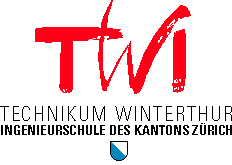
 |
Abteilung Elekrotechnik Praktische Diplomarbeiten |
|
| Power Electronics and Motion Systems |
 |
|
||||||
| student: | Callsen Andreas | ||||||
| Strobel Andrew | |||||||
| dozent: | Brom Bruno-Charles Prof., Dipl. El.-Ing. NDS ETH | ||||||
| abstract: | |||||||
|
Modern traction power supplies for locomotives must operate at a high efficiency-level. As a result, high-frequency power technology, which employs IGBT (Insolated Gate Bipolar Transistors) semiconductor power switches, has developed rapidly in recent years. The effort to reduce weight is mainly reached by increasing the internal operating frequency. Further semiconductors with high voltage characteristics are developed to obtain the goal of connecting them directly to the high voltage line. Because this is not yet possible, there is need to devide the line voltage on several moduls to provide the necessary power for the engines. One important part of the moduls is the dc-dc converter which is described in this diploma project. A resonant dc-dc converter is obtained by cascading a resonant dc-ac inverter and a high-frequency rectifier. To isolate the modules, a high-frequency transformer is inserted between the inverter and the rectifier. The higher the operating frequency, the smaller and lighter the transformer becomes. On the other hand the switching losses of the IGBT-switches increase at higher frequency, so an optimization must be found. By inserting a resonant circuit shaping a sinusoidal current, the IGBT's can be switched at zero current, what significantly reduces switching losses.
In this diploma project the currents, voltages and powers around the resonant dc-dc converter are described graphically and analytically by using the program Mathematica. Further IGBT-switches are explained in detail, especially switching losses. Finally the resonant dc-dc converter is designed with Mathematica, where the functions are given as closed-form expressions, which makes it possible to investigate effects of various parameters on the converter performance. | |||||||
| student: | Bond Marcel | ||||||
| Sumanovac Samir | |||||||
| dozent: | Lattmann Jakob Prof., Dr. sc. techn. Dipl. El.-Ing. ETH | ||||||
| abstract: | |||||||
|
The present diploma thesis deals with the realisation of a closed-loop voltage control of an IGBT- inverter for the application in an uninterruptable power supply for interlocking stations. The work is based on the dissertation DA9501, in which the output-voltage is only controlled. A closed-loop control of the output-voltage is necessary because the output-voltage is load-dependent. One of the reasons for this is the commutation failure of the line-commutated converter and another is the conversion error of the self-commutated converter. In the first place we had to look for an ideal spot where we can interfere into the existing system. We decided to use the RS-232 interface of the microcontroller to supply the controller with new information. For this we used an A/D-converter in combination with an UART. Our next step was to develop a printboard on which we placed the controller and the actual-value sensor. We decided to use a true r.m.s. chip to have the ability to control the system on the actual (r.m.s) output voltage.As a controller we decided to use a proportional-plus-integral controller, in order to eliminate stationary deviations and because it also fulfils our dynamic requirements.A Bode-plot and a step-response of the process helped us to find the system time constants and hence we were able to design a controller. Our last step was to test our system on its function and on its performance.
We hope that with this dissertation a further contribution has been made to continuing the implementation of a low cost uninterruptable power supply. | |||||||